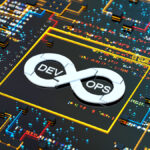
For example, according to IDC, by 2024, half of all enterprises will be using applications based on managed services that include cloud-native technologies.
OpenShift, Red Hat’s hybrid cloud ecosystem
As the leading provider of open source software solutions, Red Hat offers, with OpenShift, an entire development ecosystem for hybrid cloud environments. Powered by containers and the Kubernetes orchestrator, it enables the creation of native cloud applications or the modernization of existing applications.
Last April, the IBM-owned company expanded its offerings with the launch of Red Hat Application Foundations. This toolkit provides developers with pre-integrated components for data streaming or API management, as well as various frameworks. Optimized for OpenShift, it can also be used by third-party solutions.
The following month, Red Hat announced updates to several solutions in its portfolio. New features in OpenShift Pipelines and OpenShift GitOps allow for greater leverage of Git, an open source version control system that simplifies development and deployment in hybrid and multi-cloud environments. Red Hat has also evolved its local development environments, called OpenShift DevSpaces and OpenShift Local.
Tanzu, VMware’s cloud-native development platform
With Tanzu, VMware distributes a complete stack that covers the entire lifecycle of a cloud-native application, from its design to its operation within an on-premises infrastructure or in various cloud environments, including multicloud and edge.
Comprising four services on the “dev” side, and six on the “ops” side, the modular platform aims to provide all the tools for development and deployment (Tanzu Application Platform) but also for management, monitoring and securing multi-clusters infrastructures with Kubernetes as the common thread of its offer.
With Tanzu Kubernetes Grid, VMware offers its own Kubernetes runtime environment as a managed service. Administrators can additionally use Tanzu Mission Control for operations monitoring and management and Tanzu Observability to track and manage application performance.
Amazon Elastic Kubernetes Service, leading the way in “Kubernetes-as-a-Service” solutions.
Amazon Web Services (AWS), however, remains at the top of “Kubernetes-as-a-Service” solutions.
According to the latest activity report from the Cloud Native Computing Foundation (CNCF), 37 percent of European organizations use Amazon Elastic Kubernetes Service (EKS). AWS also comes out on top when it comes to serveless mode. Lambda, its serverless event computation service, was adopted by 66 percent of European companies surveyed.
With more than 200 services in its portfolio, AWS’ native cloud approach is, of course, not just about these two offerings. To showcase its various solutions, the U.S. public cloud giant has imagined, in a series of five blog posts, the journey of an e-commerce company in its quest for the Holy Grail of “hypergrowth.”
Azure Kubernetes Service and Azure Functions, the services of Microsoft Azure
In the same CNCF report, Microsoft Azure comes in a good second, behind AWS, both for Kubernetes managed service hosting, with Azure Kubernetes Service (AKS) and for the serverless approach with Azure Functions. As with AWS, it is difficult to cover all the services that contribute to a native cloud architecture.
However, we note the recent general availability of Azure Container Apps. This service runs application code packaged in any container without worrying about execution or the programming model. According to Microsoft, it should allow developers to focus on the business logic that adds value to their applications. They no longer have to manage virtual machines, the orchestrator or the underlying cloud infrastructure.
Like AWS, Microsoft Azure is also educating. In its documentation, the provider reminds us what a native cloud application is and its characteristics. Of course, it also highlights its own .NET development environment.
Google Cloud Deployment Manager, the Infrastructure-as-a-Code of Google Cloud
The latest hyperscaler, Google Cloud, is not to be outdone. As the originator of Kubernetes, the Mountain View firm is particularly legitimate to speak out on the native cloud approach. In a blog post, one of its expert architects details the five principles that govern this type of architecture, one of which is to favor… managed services.
On this side, Google Cloud’s offer is well supplied. Google Cloud Deployment Manager is an infrastructure deployment service based on an “Infrastructure-as-a-Code” approach similar to Terraform. We can also mention Google Cloud Build, a serverless integration and continuous delivery (CI/CD) platform.
To encourage the development of native cloud applications, Google Cloud plays on gamification. Developers who build serverless web applications on Google Cloud using Cloud Run (containerized applications) and Firebase (mobile applications) earn skill badges.


